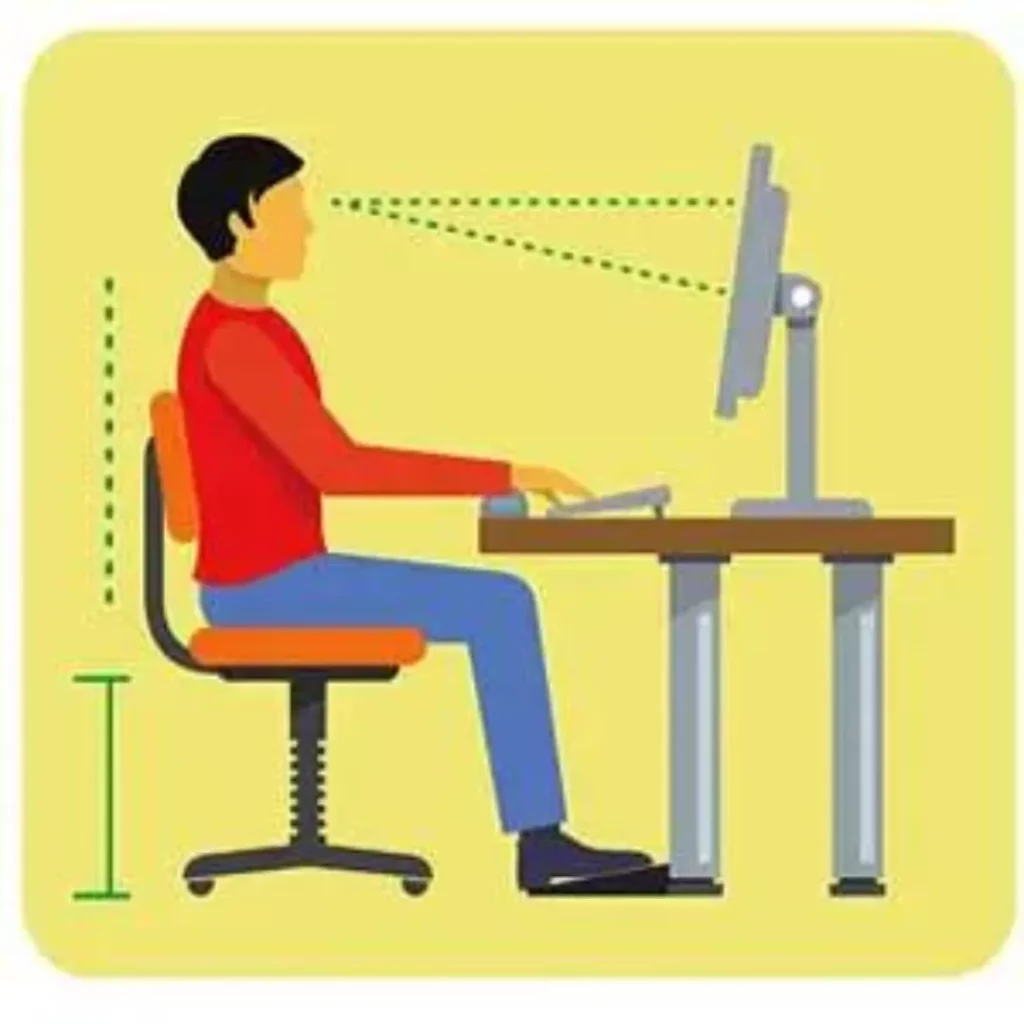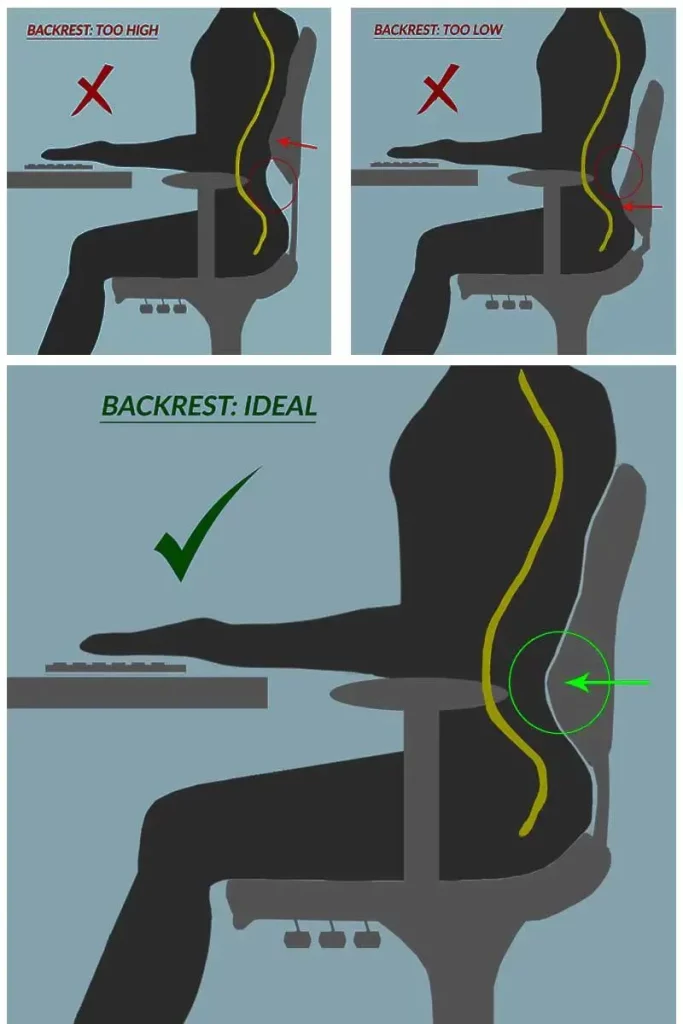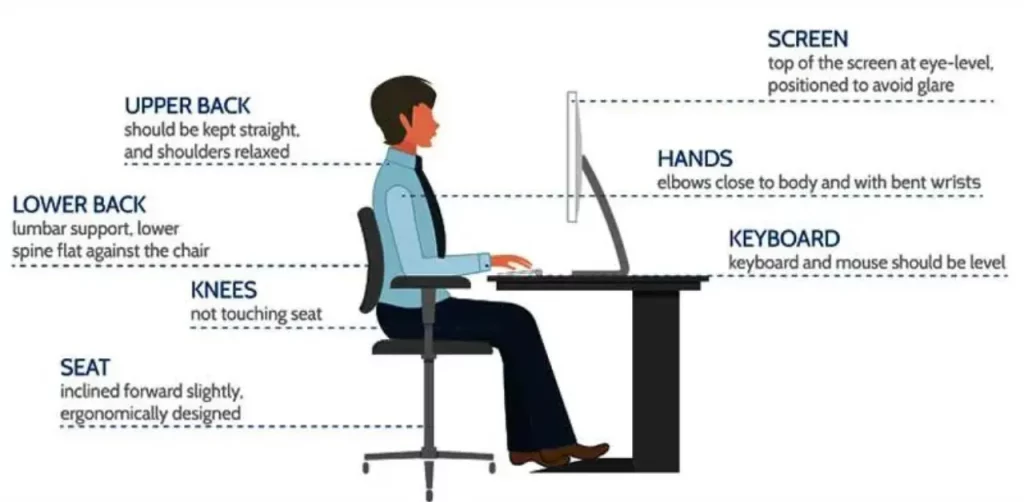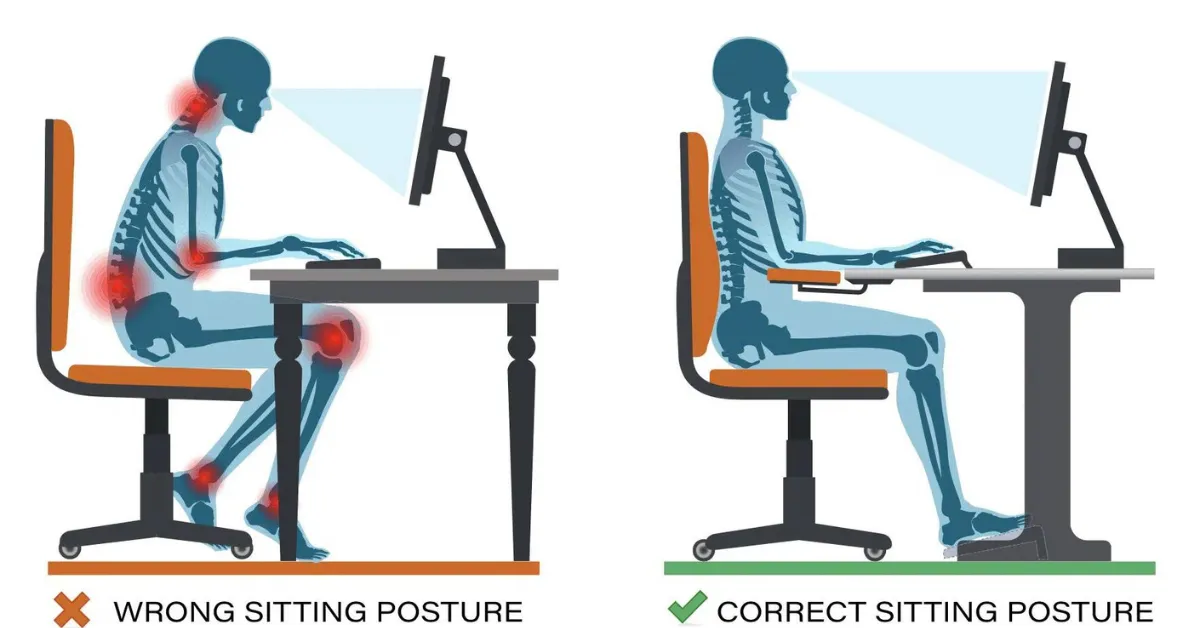Sitting tilts, the hips to one side which causes a drop in the blood circulation. It leads to severe muscular imbalances. It causes diseases such as diabetes, obesity, heart disease, lack of mental clarity, stress, and reduced lifespan. The anterior pelvic tilt pressurizes the gluteal and hamstring muscles.
If your work demands sitting for long durations, then your joints try to strike a balance in your body while you work.
Hunched shoulders may give rise to severe headaches, and pain in the neck, upper back, shoulders, and wrists. Your crooked posture ultimately leads to tension in the joints. Therefore, it is essential to have the correct posture at the desk so that you can minimize the negative impacts of sitting.

This article provides information about good posture and how to maintain your posture while sitting at a desk all day. The modern workplace does not allow you a lot of mobility, and sitting for extended periods can be inimical to health.
Read on to know about the best posture for sitting at a desk all day so that you can avert the health problems associated with sitting for long periods.
What is good posture?
Posture can be defined as the pose in which you retain the body against gravity when you are sitting, standing, or lying down. Good posture consists of preparing your body to sit, stand, walk, or lie down in ways that put minimal pressure on the muscles and ligaments while moving them.
Proper posture keeps the bones and joints aligned so that there is no pressure on the muscles. It also decreases the stress on ligaments which is responsible for connecting the joints of the spine. It stops the spine from getting fixed in strange positions. It also enables the proper use of muscles thus preventing fatigue, strain, and pain in the muscles. It inhibits a backache. Improper posture may result in arthritis due to the abnormal wearing of joint surfaces. Good posture also enhances efficiency. Therefore, it is essential to maintain the best posture for sitting at a desk all day.

How to sit at a computer?
If your job involves working with a computer, then you should follow the proper sitting posture at the computer. Here are some tips to check whether your posture is correct.
1. Your computer should be in your line of sight:
Your monitor should be positioned in such a way that your eyes are in level with its top. Desktop PCs typically have a size which makes it easy to adjust them to your line of sight. However, it may be difficult to adjust the laptop because the screen and the keyboard are affixed together. Monitors should be placed 30 inches away from your eyes. People tend to set the monitor far apart and then slouch to see their screen. Doing this might put your body in painfully awkward positions.
2. Relax your shoulders:
Do not keep your shoulders stiff and high. Relax your shoulders and keep them low but ensure that they are not slouched. You should not feel as if you are lifting your shoulders.
3. Put your arms in line with the floor:
If you need to sit for extended periods, ensure that you have proper armrests. They allow you to keep your lower arms parallel to the floor. Instead of holding them up regularly, you should provide them with adequate support. Your armrests should be adaptable so that you do not need to use your shoulder, neck, and upper back muscles to support your arms for the entire day.
4. Keep your keyboard and mouse close:
It is essential to keep your keyboard and mouse close so that you do not have to reach out for them. Reaching out for the keyboard may lead to severe stress on the shoulders and neck. You should be able to work conveniently with your arms being bent at the elbow. Your keyboard should be placed at the edge of your desk so that your upper arms are aligned with your body while typing. Your mouse should fit the curves of your forearm, and you should be able to grip it properly. The keyboard should be positioned in a manner that lets you relax your wrists in between work. You should not rest your wrists or forearms on the hard surface of the office desk. It can affect your blood circulation and lead to the confinement of the nerves within the wrists and forearms.
5. Ensure that your feet lie horizontally on the floor:
You should keep your feet as well as toes flat on the floor. Do not tilt your feet only to let the toes touch the floor. If you are wearing heel shoes, then you can remove them for your comfort.
6. Position your hips close to the back of the seat:
You should not droop in your chair. Ensure that there is only a little gap between your hips and the seat. Make sure that your chair supports the gentle inward curve above your bottom while you are sitting.

7. Hold your upper back straight:
It is essential for you to hold your upper back straight. Moreover, your chair should support the natural curve of your lower back. The lumbar support is necessary to stop you from slumping.
8. Place your upper legs perpendicular to your body:
You should ensure that your upper legs form a 90° angle from your body. If you are short, you should opt for a chair with footrests so that you do not pressurize your knees while sitting. If you are tall, then you require a high chair so that it can accommodate your legs. Ensure that your desk is also high and lies close to your chair.
9. Place your screen at an arm’s length:
Make sure that you sit upright and keep your screen at a full arm’s length distance. Do not keep your monitor low. If you do so, you need to keep bending your neck to look down. It pressurizes the neck muscles because they have to work hard to keep your head in that position. Adjust your screen so that you can read the upper half of the screen without bending your neck.
10. Do not lean on to the side:
It is not a good habit to keep leaning on one side. Although you might want to rest one arm, it might lead to a curve in your spine. You should also try to avoid crossing your legs while you are sitting.
11. Change your position every half-hour:
You need to adjust your position in every thirty minutes. Shifting and shuffling in your chair may make you restless and uncomfortable. If you do not try to maintain a proper sitting posture, you will end up slouching down in your chair. Therefore, you should take a brisk walk every thirty minutes instead of trying to find different right positions to sit. Try standing during lunchtime and at conferences. You can stretch, drink water, and do a few squats to decrease the pain, enhance your concentration, and get rid of fatigue.
12. Stretching or Yoga:
If your office has a gym, you can exercise for some time to enhance your productivity and reduce your backache. You can try out the couch stretch, the thoracic bridge stretch, or Grok stretch to reduce the pressure on your back. Practice yoga or meditation to enhance your blood circulation.
13. Make sure that the objects that you use frequently are within your reach:
The items that you often use such as stationary, files, phone, and notepads should be placed close to you. Repeated stretching can cause strained muscles and joint pain.
14. Use headphones if your work involves speaking on the phone:
If your job requires you to talk on the phone while taking notes or typing, you can invest in a speakerphone. If you are unable to do so, you can purchase good quality headphones. Tilting your neck to hold the phone for extended periods may lead to stiffness, pain in the muscles, and ligament damage.
So, if you were thinking about how to sit at a computer, you have your answer now. Follow these tips to minimize the wear and tear on your muscles and bones. Improving your posture can go a long way in avoiding injuries, pain, and soreness in your body. Paying attention to your health is essential if you want to excel in your career.
Conclusion
The best posture for sitting at a desk all day will enable the proper distribution of gravity throughout our body thus preventing excessive strain on any particular structure. Moreover, it will also enhance your circulation and digestion. A good posture also augments your appearance by portraying you as a confident individual. Slouching and lousy posture is seen as signs of sluggishness and depicts a lack of professionalism. Therefore, the importance of good posture lies in augmenting your health as well as improving your image at the workplace.



